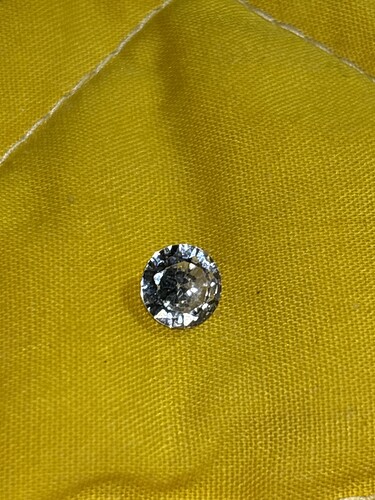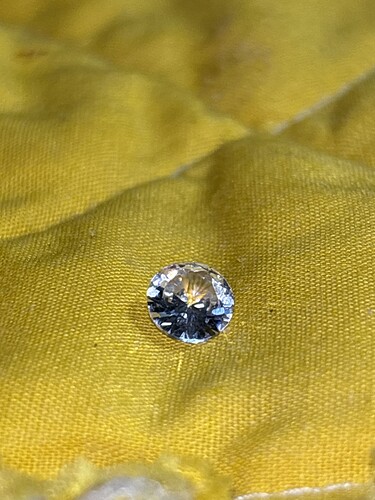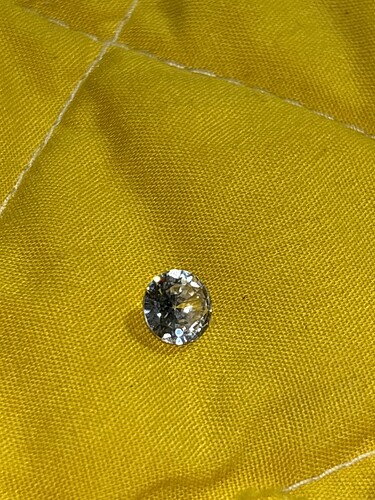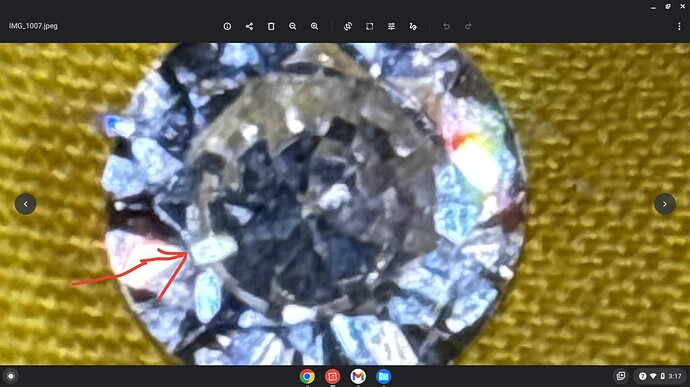I found this last night in the middle of the street on a walk with my wife. I assumed it couldn’t be real but then I started doing what tests I know and so far, contrary to my skepticism it has passed them. Can anyone confirm if this is or isn’t a diamond by these pictures? Any help would be greatly appreciated.
What tests did you do? Results? What is the size and carat weight of this stone? Do you have a diamond tester?
It’s 1.35 carats I did the fog/breath test, the scratch test, the water test, the dot test, the newspaper test all with results that would indicate the real thing.
I do not have a diamond tester
I would suggest you pick up a diamond tester, they are realatively inexpensive. That would give you a positive ID.
A diamond tester is a good tool but “Buyer Beware”. Some testers are not very accurate. I would question some of the models being offered on Amazon and Ebay, etc. Without calibrating them against a known diamond, there can be uncertainties. Articles testing several models have reported they have repeatability issues, even when testing the same stone.
The dot test is a good indicator, and similar in nature as the newspaper test. But please take note, there are some issues with these tests because the type of cut on the stone may optically simulate the behavior expected from a diamond.
The scratch test is also not accurate because Moissanite and Cubic Zirconia are also hard materials. Plus, scratching anything with a diamond is not recommended, because of their brittle nature. You can actually reduce the value of a stone if it is damaged or even worse…it shatters into pieces.
A very accurate way to determine the type of stone is measuring the specific gravity. This can be done with a very simple setup. And since you have weighed the stone, you already have a scale that can do this test.
Diamonds and their simulants are distinctive as indicated in this article:
the breath/fog test is not reliable. The dot test relies of birefringence. Diamond testers rely of thermal conductivity. SpG is a starting point. There’s no easy home way to determine a real from a simulant other than SpG… but that just the start. A professional jeweler should be able to help. They can determine the refractive index with a refractormeter. Even if all the criteria are met for a real diamond, and not a simulant, there is still no way other than microscopic examination for inclusions to tell whether a real diamond is a natural one or synthetic. I think that getting it examined by a professional jeweler/gemmologist would be your best bet for an accurate ID. If it is natural, the 4 C’s also can be determined by a professional. It’s over 1 ct. so cut, clarity, and color will be the determinants.
Thanks for the help everyone I’m going to take the advice and have it looked at by a professional
@StevenH26783 puts the best suggestions on the table. ![]() Hope you find the answer! Please let us know what you learn! The more information we get to share, the more knowledge we gain as a community!
Hope you find the answer! Please let us know what you learn! The more information we get to share, the more knowledge we gain as a community!
Also, the diamond industry has been laser etching stones for some time now. Not all, but it is becoming more frequent. This is the case for those stones with a patent or trademark or those certified by a reputable test lab. Typically, one carat and above. This also includes Moissanite and CZ. Ask the professional, if they see any markings on the stone. Sometime the marking will include a serial number. That could give some traceability to who it belonged to.
You are correct sir ! DeBeers was one of the first to brand their diamonds by laser incribing on the girdle the name. The Chinese started to brand the DeBeers name on synthetic diamonds… this was back a couple of decades ago. The GIA put out a warning. Traceablility should be the standard for every valuable precious stone. Unfortunately, it’s not.
I enlarged your pic of the diamond table and detected what appears to be a 'fish-eye". There’s a very good chance this is indeed a diamond because “Fish-eyes” are only seen in round badly cut /shallow diamonds, not simulants.
Just Google “Fish-eye effect” “Fish eye diamonds”
Cheers
Thanks for pointing that out. It does seem to have the “fish eye”.
Questions: Is it “hidden” because of the background material the diamond is sitting on? Would it be more distinctive if it was on a white background? I suspect if the camera angle was looking straight into the table, it would be more visible, right?
Thanks! I have no experience working with diamonds yet… that’s on the bucket list… ![]()
Yes, the fish eye would be more evident if photographed on a plain white sheet of paper and at a 90 degree angle of the table
The pictures make the stone in question look blue. If that is the case and the stone is in fact a natural diamond… then you are rich. Even if it is diamond, it may very well be man-made, or synthetic diamond. This is not an identification you can make on your own. The refractive index is above the limits of a refractometer. Many jewelers do not even have the means to tell the difference. They may have testers available, which will only tell whether the diamond is ‘questionable’ and must be referred’. In which case the final determination will have to be made by one of the main gemology labs like GIA. If it is synthetic… you are not rich.
I really do appreciate all the replies, your comments were very helpful, I tested it for specific gravity and it fell in the range for CZ. So, finally, I tried the flame test. The interior of the stone was completely wrecked after putting it in the cold water. Unfortunately confirmed not a real diamond. But again, the knowledge gained from the experience and from you all was invaluable. Thanks again
How did you do “the flame test”
I hope that you did not heat it in a flame then dunk in it cold water, which is what I surmised that you did… thermal shock can destroy any gemstone… diamonds are only relatively more resistant… they too can be cracked and destroyed… Never heat and dunk any gemstone… jewelers have to remove all large expensive stones before doing a repair that requires heating the metal… or provide for a heat sink and heat shield for the stone… even then it’s dicey, without removing it… if your stone was a CZ you didn’t lose much… wrecking a real diamond, synthetic or natural would have been a disaster… same goes for corundum stones which are also more thermal shock resistant, but they too can be cracked… any internal stress that was built in the stone as it grew in nature will potentially cause it to crack…other stones like emeralds are always filled with cracks, thermal shock will destroy these stones as they are far more susceptible to falling apart…If specific gravity already told you it was CZ, a confirmatory test DYI would have been to get a refractive index… those two would have nailed it down to CZ…good enough to stop then.
I second Troy’s comment. I got a cheap diamond tester from amazon and the one I got does indeed work for clear diamonds, but only those, nothing else. It also tests both lab grown diamonds I have as “natural”, although it purports to be able to tell the difference between both. It also purports to identify or aid in the identification of other precious gemstones but it simply does not, it’s pretty useless in that regard. Maybe a better quality tester can, but maybe not. As I understand it, the characteristics of lab diamonds are to the point where they are nearly indistinguishable from natural stone, except with professional lab analysis from a quality lab. For that stone, I’m guessing you have to go that route to know, but maybe I’m wrong.
thanks for pointing that out… appreciated.
diamond testers based on thermal conductivity can never distinquish a natural from synthetic…both have the same composition and crystal structure… it will distinguish a diamond, both natural and synthetic from other simulants as diamond has the highest thermal conductivity of all gems… in fact, the highest thermal conductivity of all materials… hence the great interest in using them as heat sinks for semi conductors…not much use in determining silicate minerals all of which are relative thermal insulators…except for pure quartz which has a higher thermal conductivity… trying to use one to split hairs between other silicates is not within it’s sensitivity range. It’s a single purpose instrument.





